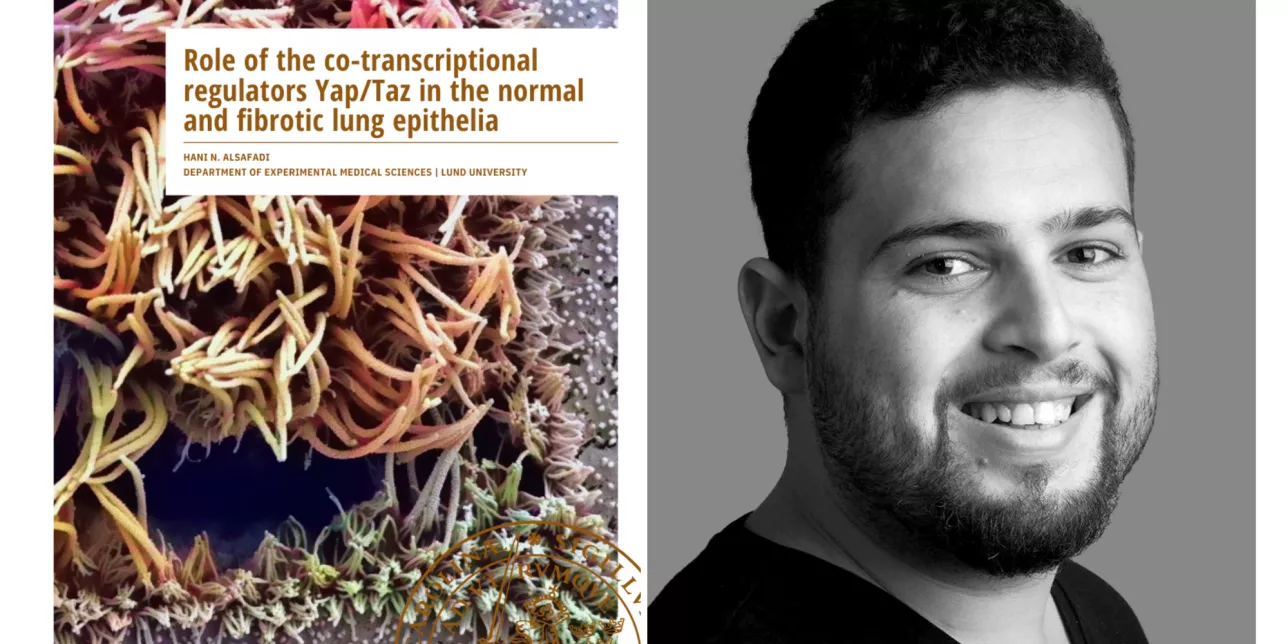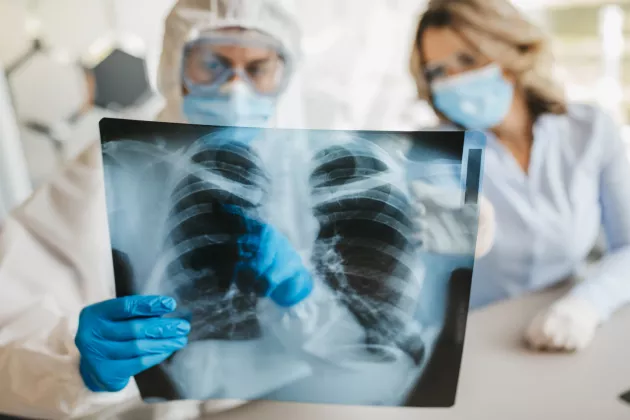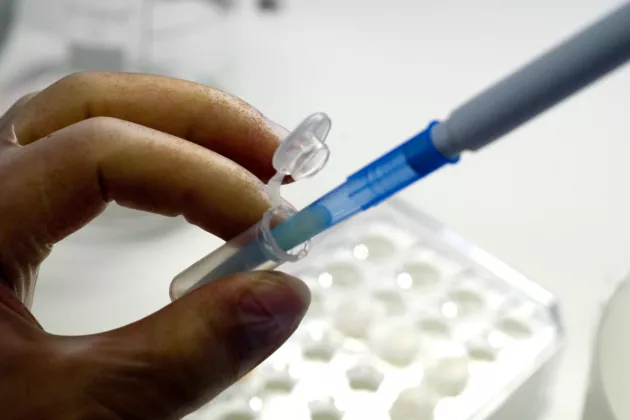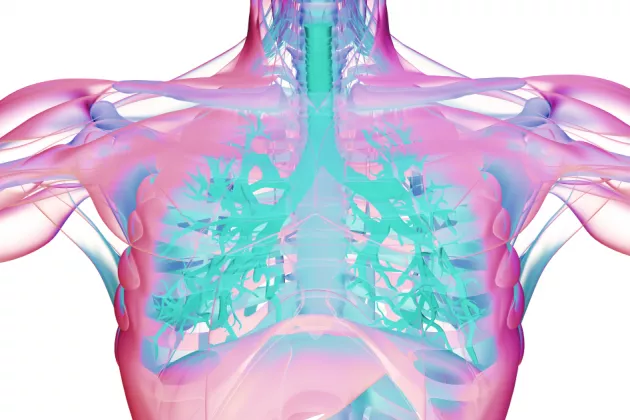What have your Ph.D. studies focused on?
“The focus of my Ph.D. studies has been lung fibrosis, and more specifically, idiopathic pulmonary fibrosis (IPF). IPF is considered a rare disease, though this status may very soon be lost as both prevalence and incidence are increasing worldwide. IPF is a deadly disease with no available cure, the exact cause of which remains unknown. It can be described as an excessive injury to the lung that stiffens it, preventing the patient from breathing.
Right now, the most common theory is that the disease could potentially be triggered by an initial injury to the lung epithelium which in turn induces an abnormal repair pathway, leading to damage of the lung. Lung epithelial cells are located on the surface of the internal parts of the lung, and they are responsible for gas exchange (i.e., breathing). These cells are heavily damaged in patients with lung fibrosis.
Currently, there are only two approved FDA drugs available to treat IPF, but these drugs only slow disease progression, offering limited relief of symptoms for these patients. So, in the end, the only option is lung transplantation. Though, with the need for lung transplants increasing globally, and a limited number of donor's lungs, many patients only survive for a few years once diagnosed.
Among the reasons the current approved drugs are not very efficient is the fact that they do not target a specific mechanism in the lung. Thus, in order to find good therapeutics and better treatment options, we first need to better understand the disease mechanisms at play. Previously, our research team had found that two molecules, or more specifically, co-transcriptional regulators, known as YAP and TAZ, are involved in the damage of the lung epithelial cells. YAP and TAZ are known for their ability to sense changes in stiffness and are responsible for a wide range of activity in normal, healthy lungs and other parts of the human body. However, in lung fibrosis, these molecules are abnormally active and are responsible for causing disease characteristics like tissue scarring.
So, in my Ph.D. project, we set out to develop the tools needed to explore the role of the signaling pathway that regulates YAP and TAZ in the healthy and fibrotic lung epithelium and to identify the transcription factors that YAP and TAZ interact with to carry out their various functions. The goal is to determine what contributes to the disease, whether this can be targeted, and if so, what are the best ways to do so. Using state-of-the-art techniques, we were able to identify some of the roles of these molecules in the different types of cells in health and disease.
To do this, we first developed a method to simultaneously isolate proximal and distal lung progenitor cells from an individual mouse with the aid of a 3D-printed surgical guide. Using this method, we found that the precision of dissecting the lung lobes affects the purity of the isolated distal progenitors and how they behave in organoid assays. The ability to separate the epithelial compartments of the lung may improve our ability to study diseases that effect both of the proximal and distal lung epithelia.
We also found that the Hippo signaling pathway, responsible for controlling YAP and TAZ activity, is dysregulated in the fibrotic lung epithelium, leading to an increased presence of YAP and TAZ in the cell nucleus as well as known downstream targets. What is interesting about this is that we also found that this activation also contributes to changes in the extracellular matrix in the fibrotic lung epithelium through a collagen crosslinking enzyme. In the last part of my thesis, we found that by inhibiting YAP and TAZ, we could produce a better disease outcome or improve the fibrotic injury - indicating that targeting these two molecules may be an option to treat fibrosis. This was tested in vivo and mice models, using a treatment with an FDA-approved drug that was later discovered to also target some of the transcriptional interactions of YAP and TAZ.
We found that while YAP and TAZ are known to be responsible for a wide range of biologic processes, targeting their profibrotic activity and promoting their pro-regenerative activities may result in beneficial effects for IPF patients. Overall, our findings set the basis for identifying exact targeting mechanisms that can be used in the development of new therapeutics for IPF,” explained Hani.
Can you tell us more about the cover of your thesis?
“My cover comes from our paper that was accepted as the cover of the journal, Stem Cell Reports, at the end of last year. But before we had gotten that call, I had already chosen it as the cover for my thesis book. So, it is an image of a ciliated cell that was differentiated from the proximal cells that we isolated with the new method we developed. We isolate the proximal epithelial cells and then grow them on an air-liquid interface and expose them to air. After this, they become differentiated into a mucociliary epithelium, and this specific cell is differentiated into a ciliated cell. So usually, with the differentiation assay, the cells differentiate into either ciliary cells or mucosal cells. In this case, we took an image using the scanning electron microscope of one of the ciliated cells.
The original image was produced in grayscale, so we added the color manually afterward using Photoshop and the neural filter – it’s this function that is used to recolor old black-and-white photos. I tried it at first just to see if it made any difference, and the result was so cool that I saved the image thinking this would be good for something. So, when the journal called and said our paper had been accepted and we could submit a cover image, I knew which image to pick right away,” highlighted Hani.
How did you end up doing a Ph.D. at Lund Stem Cell Center?
“So I am originally from Palestine, from Gaza City, born and raised. Though I have lived abroad now for a long time while pursuing my education. To start, I did an IB International Baccalaureate in Italy before earning an undergraduate degree in biochemistry in the United States. That was where my research career took off, at Northwestern University in Chicago, Illinois, in the USA.
Initially, I had wanted to go to medical school after my bachelor's, but the process in the states is very difficult for internationals. So, I decided to put that on hold and get into research instead and I found research exciting. That’s when I decided to get into research, either in the states or outside of it. When the opportunity presented itself for me to go to Germany in the field of lung fibrosis, I took it. During my time there, I also started taking master's courses.
That’s where I first met my current supervisor, Darcy Wagner, who was a postdoctoral researcher in the same research program at the time. When she started her lab here, she recruited me to Sweden. But before deciding to come to Sweden for the Ph.D., I came here for a small two-month-long project in a different group to get a feel for the country, and I liked it at the time.
So, I liked Lund, I liked the country, and then of course the topic is something that I'm very passionate about. Plus knowing my supervisor in advance, I was able to have a lot of input in designing the Ph.D. project early on. I mean in some cases, people come into a new project, a new environment, and then they spend the first period finding their place and building their project. But for me, since I had already been in the same field, I was able to focus exactly on what I wanted to focus on in my Ph.D. We had a very ambitious plan, and somehow we managed to pull through. I think the thesis right now is quite close to the actual initial plan,” revealed Hani.
What have you found the most enjoyable during your Ph.D. studies?
“There are a few things, of course, that have been enjoyable about the Ph.D. One of which is the excitement of working on something new all the time. This is the main reason we do this type of work. The other aspect is something that I didn't expect to enjoy, which is mentoring and teaching.
In our lab, I've had the opportunity to mentor several bachelor’s and master’s students, and I found it very enjoyable. It's nice to see them develop their analytical and lab skills from beginning to end and in a short period. The way I approached mentoring was that I never had a student work on something that was already done, I always had them join me for the new things that I was working on. So, for the last part of my thesis, they joined me for the optimization of all the methods for that last paper, and some of them will even be authors of that paper.
I feel like in the scientific field in general, the outcomes are usually, you get a paper ready or published after a very long time and a lot of work, and with mentoring, you see the result very quickly. You get to help someone become a little scientist, and that makes the time worth it,” described Hani
What has been the most challenging aspect?
“The biggest difficulty during my Ph.D. was related to the pandemic, and this was due to the unpredictability of things which made a huge difference. So not due to the University since it never officially shut down, but many other things did shut down. This caused a lot of delays which meant that some of the studies had to go on hold for a little bit. For example, the amount of progress I've done on the last part of my Ph.D. thesis with the transcription factors, if it was not for the pandemic, this would have been a lot closer to publication than it is right now. Overall, though, I would say our response to these challenges was positive. The time was not wasted, so I managed to diverge my focus on other things that could be useful in the short term. This is why if you look at my thesis book, I have many co-author papers, and that was a symptom of the pandemic where I couldn't do some work on my project, so I spent the time collaborating with others where I could be effective. So, this was useful and is something that I think is very important for one’s development as a scientist.
Another challenge was the need for collaborative work to accomplish these more complex projects that can't be done within your lab, and you must collaborate with others. Sometimes this meant working with researchers in other cities and countries and managing between getting animals for your study, arranging travel for the right people, and then delivering the samples at the right time in the right place. When it's something that has to do with optimization, just imagine how difficult it is. I remember at some point about a year in, I had no progress because we tried an experiment, and it didn't work the first time around. So we had to optimize more and to get to the next round, it took almost a year to arrange it. That was very frustrating because these are all things you cannot control yourself. I think that's the most difficult part.
In terms of other challenges, this has changed now, but when I started, the Ph.D. coursework requirements at the University were not well distributed initially. You had to wait for courses to become available, and then it was first come, first serve. So, you didn’t always manage to get the course that you wanted, and then sometimes the courses could be held at a very difficult time during experimentation. So, this was a little stressful in the beginning,” replied Hani.
What are your plans following your Ph.D. defense?
“What comes next is still up in the air. For me, the biggest priority is to do what's best for me and my family rather than just trying to only satisfy my career goals. I’d like to have a good work-life balance.
One plan is to shift directions towards data science and a role within data analysis and working with big data sets. But of course, when, where, and how is a big question at the moment. One of the good outcomes of this Ph.D. process has been that before I had of course read a lot of papers using big datasets and was always excited to see and read about this. Then during my Ph.D. I started working with big data, and I found data analysis even more exciting and quite rewarding to work with. So that's why I decided that after completing my Ph.D., I would try to, as much as possible, direct my career in that direction and learn more about data science instead of working in the lab only,” noted Hani.
Any tips or advice for future Ph.D. students?
“I have quite a bit of advice that I could give, but the main take-home would be to balance between satisfying the requirements of the Ph.D. with your own career goals as a scientist. I know that these things are supposed to be parallel to one another, but sometimes you must make small decisions along the way that will determine whether you have a more or less stressful Ph.D. period or not. For example, how soon you think of certain requirements for your Ph.D. can contribute to this. The sooner you get your draft of the plan of what the publication requirements are throughout your Ph.D., rather than just focusing on the big picture and the scientific field the better.
Sometime in the middle of my Ph.D., I tried to simply focus only on the field regardless of when to publish and how. At that point, I had a lot of papers, but not necessarily all of them ended up in my thesis, just because I didn't plan properly in the beginning. My Ph.D. has been wonderful, but if I had just focused on getting the Ph.D. requirements out of the way, then I would have made sure to have my first author paper first to be in a more comfortable position and then continue from there. I would also have been better at planning in the beginning if I’d known the circumstances we would through with the pandemic as well,” reflected Hani.





